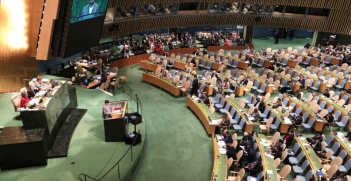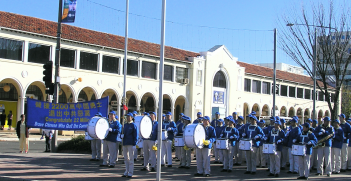The Trade Dispute Between Australia and China Should Be Taken With A Grain of Barley

When Australian trade with China is disrupted, commentary quickly gravitates towards the frame of economic coercion. With such deeply intertwined trade relations, coercion is, in reality, only one possible cause.
Referring to recent Chinese measures taken against Australian barley and beef, the headline of an article in The Economist on May 21 wasn’t steeped in subtlety or couched in caveats. It stated matter-of-factly: “China punishes Australia for promoting an inquiry into COVID-19.”
As the United States Studies Centre’s Ashley Townshend noted in a report published in April, a feature of the historical and international experience of Chinese coercion, economic or otherwise, is that China frequently operates in the “grey zone,” a rung below open conflict, and with “plausible deniability.” This means that Beijing can hardly complain when developments in the trade space prompt plenty of hot takes that punishment is being metered out. But nor do Beijing’s tactics absolve commentators of a responsibility to keep abreast of hard data, even if these only become available with a lag. To simply let earlier headlines and assessments stand without critical reflection – and, if necessary, re-evaluation – is intellectual laziness at best and a form of propaganda and disinformation at worst.
With the annual value of two-way goods trade between Australia and China now exceeding $225 billion, there is a large surface across which disruptions can occur. For example, over the past decade there has been a well-documented increase in trade restriction measures applied by G-20 countries. The typical purpose of such measures is to protect domestic industries, not coerce trading partners. Within the G-20, the leading initiators were the United States and India.
Crises can also lead to trade being blocked. In April the World Trade Organization found that 80 countries and separate customs territories had introduced steps such as export prohibitions in response to the COVID-19 outbreak.
In February last year, a Reuters report claimed that a “ban” on Australian coal had been implemented in the north-eastern Chinese port of Dalian. The following month brought more stories of the “ban” having spread to ports further south, with The Guardian contending that “few doubt that there is a considerable political dimension.” Recalling this episode last month, Townshend described it, along with reports in 2018 of Australian wine facing port processing delays, as instances of where “Beijing has used boycotts to pressure Canberra before.”
How strong was the pressure that China unleashed in the form of these “bans” and “boycotts”? At the end of 2018, immediately prior to reports of coal bans, Australian Bureau of Statistics data show that the annual value of Australia’s coal exports to China stood at $14.3 billion. By June 2019, the value of coal exports had fallen ever so marginally to $14.1 billion. For context, a year earlier in June 2018, the value was $13.1 billion. Turning to China’s customs statistics, Australia’s share of China’s coal imports stood at 42.7 percent in December 2018. This drifted to 42.2 percent in June 2019, a trivial reduction. In 2018, the value of Australian wine exports to China, in fact, leapt by 18 percent, hitting record highs.
So let’s be clear: despite all the headlines and references to Chinese coercion directed at Australian coal and wine there is little evidence to substantiate such claims. Of course, it might still be reasonably asserted that China was guilty of making threats against Australian trade. But in any sensible accounting threats and bluster do not equate to a “ban” or a “boycott.”
The fact that threats have not translated into action may also reflect the astute response of the Australian government, which has consistently made clear that it will not tolerate even hints of coercion. That an Australian Prime Minister has not received an invitation to visit China since 2016 plainly demonstrates that Canberra is not in the business of pandering to Beijing’s wishes.
The latest barley episode is different to coal and wine because in applying a tariff of more than 80 percent, allegedly for Australian farmers dumping their product in the Chinese market, a stop will likely be put to the entire $380 million worth of barley trade over the past 12 months. That said, Australian barley will find an alternative, albeit lower-margin market.
Tariffs were also the culmination of an 18-month long investigation that China launched back in November 2018. This meant that Australian farmers had an opportunity to mitigate the risk by, for example, switching out of barley for other crops. Back when China’s investigation began – and long before Australia’s calls for an independent, international inquiry into COVID-19’s spread – my UNSW colleague, Weihuan Zhou offered a prescient analysis. He noted that it was the first ever anti-dumping allegation that China had levelled at Australia. Meanwhile, Australia already had 18 anti-dumping measures in force against China. Dr Zhou surmised: “China’s main concern isn’t barley, and it isn’t the dumping of Australian products. It’s Australia’s use of anti-dumping against China.”
And in all of this, the broader trade backdrop between Australia and China should not be ignored. Despite China’s domestic economy slowing sharply due to COVID-19, the value of its total goods imports from Australia in the first four months of 2020 actually exceeded that in the same period the year before. Australian businesses heavily engaged with the Chinese market need to factor the possibility they could become targets for coercion into their business models. The latest Chinese actions, whether real or bluster, only add to the case for doing so.
But with their own money, time, and goodwill on the line, it is odd that some commentators apparently imagine them to be wilfully naïve. It is not only in the interest of Australian businesses that the risks from China engagement be evaluated based on facts not fears, and also weighed against the opportunities. It is in the broader national interest too.
Professor James Laurenceson is the director of the Australia-China Relations Institute (ACRI) at the University of Technology Sydney.
This article is published under a Creative Commons Licence and may be republished with attribution.





